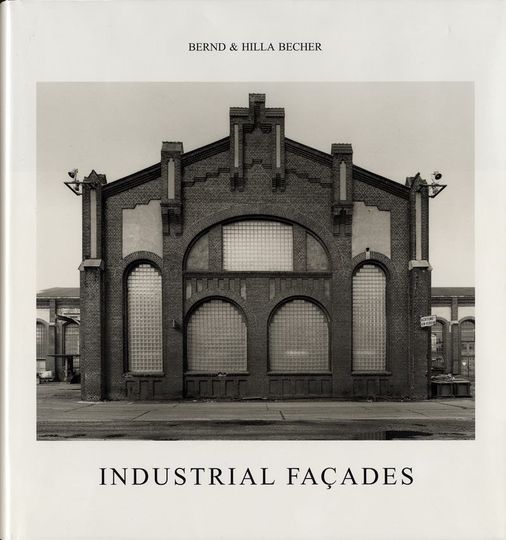#bernhard becher
Photo
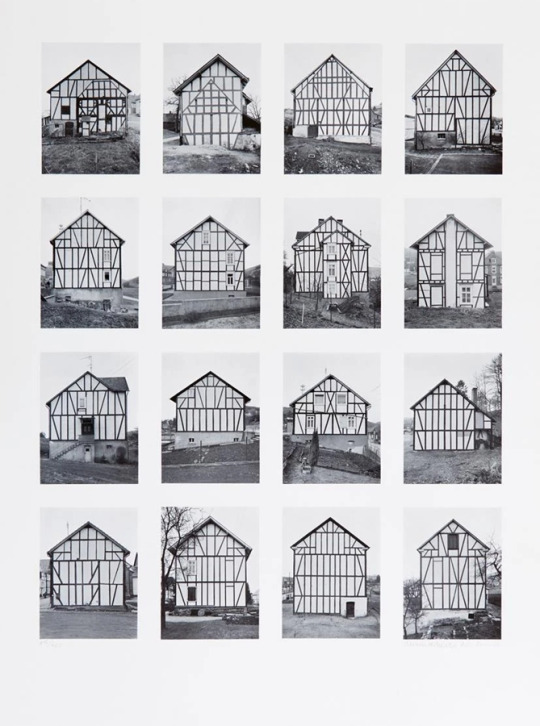
Bernd & Hilla Becher, Fachwerkhäuser, (offset lithograph on smooth paper), 1974 [© Estate Bernd und Hilla Becher]
284 notes
·
View notes
Text
BASIC FORMS > BERND & HILLA BECHER
*CLÁSSICOS

Os alemães Bernd (Bernhard,1931-2017) e Hilla Becher (1934-2015) foram fotógrafos que juntos produziram uma extensa documentação tipológica de estruturas industriais na Alemanha e em outros países da Europa e nos Estados Unidos. Suas imagens têm um caráter que chamamos de "straight" ou seja sem firulas ou maneirismos, observando sempre um plano direto, em preto e branco, que serviram como estudos do que eles chamaram de "Escultura Anônima", um registro das relíquias arquitetônicas em extinção, como minas de carvão, siderúrgicas, caixas de água, silos de grãos e tanques de gás entre outras construções.
A importância da dupla pode ser avaliada pela Bienal de Veneza de 1990 que concedeu o Leão de Ouro da Escultura para eles. No pavilhão alemão daquele ano, foram expostas as séries de instalações arquitetônicas, cujo o mainstream da pesquisa da arquitetura não dava muita importância. Esculturas, no entanto, os Bechers nunca criaram. Eles simplesmente fotografaram as estruturas industriais abandonadas. Sem eles, realmente teriam continuado anônimas, no paradoxo do título de suas séries. Entre os inúmeros livros publicados, encontramos a reedição de seu Basic Forms ( Prestel London, 2020), originalmente publicado em 2014 pela Schirmer/Mosel Verlag Munich como Basic Forms- of Industrial Buildings, uma síntese de 40 anos de trabalho pelo mundo em busca da representação de tipologias e topografias peculiares.

Hilla e Bernd conheceram-se quando estudavam pintura na Kunstakademie Düsseldorf (Academia de Belas Artes de Dusseldorf) instalada na cidade dividida pelo rio Reno, com a Altstadt (Cidade Antiga) na margem oriental e as modernas áreas comerciais. Seguiram um romance que os levou a uma carreira colaborativa. Eles contam: “Tomamos consciência de que estes edifícios eram uma espécie de arquitetura nômade que tinha uma vida comparativamente curta – talvez 100 anos, muitas vezes menos, e depois desaparecem. Parecia importante mantê-los de alguma forma e a fotografia parecia a forma mais adequada.” Seus métodos e técnicas de trabalho influenciaram uma geração de fotógrafos hoje conhecida como Escola de Düsseldorf, que inclui nada menos que os consagrados alemães Andreas Gursky, Thomas Struth, Thomas Ruff e Candida Höfer. Suas obras estão incluídas nas coleções do Art Institute of Chicago, do Museum of Modern Art de Nova York, da National Gallery of Art de Washington, D.C. e da Tate Gallery de Londres, entre inúmeras importantes instituições do mundo.

O inventário fotográfico destas estruturas industriais é sem dúvida uma das realizações mais interessantes e significativas da produção fotográfica dos séculos XX e XXI. Apoiando-se na ideia da tipologia e uma visão comparativa, o casal entrou sistematicamente no assunto revelando constantes variações destes complexos que nunca eram chamados de "arquitetônicos" muito menos interessantes para a arte estabelecida à época do início desta produção ( anos 1960 aos 2000) construindo uma impressionante coleção de séries tipológicas, criando assim uma inestimável enciclopédia fotográfica sobre a cultura industrial de uma época final que combina a taxonomia científica com o empirismo estético. O levantamento mostrado em Basic Forms, segundo seus editores, ilustra ambos: as "formas básicas" da arquitetura industrial anônima e o conceito estético da fotografia de Bernd e Hilla Becher.
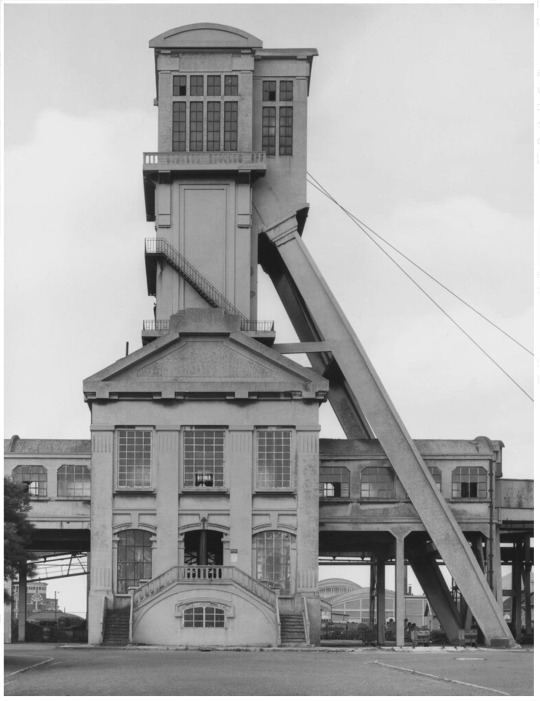
Basic Forms contém um texto instigante do belga Thierry de Duve, professor visitante de Arte Moderna e Teoria da Arte Contemporânea, nas universidades de Lille III e Sorbonne, ambas na França, além de crítico de arte e curador, como do Pavilhão belga Na Bienal de Veneza de 2003, e autor de livros importantes como "Pictorial Nominalism; On Marcel Duchamp's Passage from Painting to the Readymade (University of Minnesota Press, 1991),"Bernd and Hilla Becher" (Schirmer Art Books, 1999), entre dezenas de outros, publicados na Inglaterra, Alemanha e Estados Unidos.

As fotografias são feitas com uma câmera que utiliza negativos no formato grande 20X25cm, no início da manhã, em dias nublados, para eliminar sombras e distribuir a luz de maneira uniforme. O tema é centrado e enquadrado frontalmente, com suas linhas paralelas dispostas em um plano o mais próximo possível de uma elevação arquitetônica. Nenhum ser humano e nenhuma nuvem ou pássaro no céu interferem na rigidez. A imagem não transmite nenhum humor, nem o menor toque de fantasia que perturbe sua neutralidade ascética. Raramente a recusa do Fotografte ( o fotografado) subjetivo é feita e a Sachlichkeit (Objetividade) da lente da câmera foi perseguida de forma tão sistemática, reflete Thierry de Duve.
Considerando a possibilidade de uma fotografia ser totalmente desprovida de estilo, a dos Bechers poderia ser entendida deste modo. Um trabalho que segundo a crítica pertence à tradição arquivística da fotografia na qual o francês Eugène Atget (1857-1927) e o alemão August Sander (1876-1964) – fotógrafos que fizeram questão de não serem artistas e se destacaram, embora hoje sejam considerados como tais. "As fotos de Bernd e Hilla poderiam ser descritas como puros documentos se não houvesse algo que nos impedisse de colocá-las, sem mais delongas, na categoria da foto documental." diz Duve.

O crítico em seu texto explora o ideal da imagem conceitual e recorre a um provérbio chinês apócrifo: “Quando o homem sábio aponta para a lua, o tolo olha para o seu dedo”. No caso dos fotógrafos, o tolo olha para a fotografia e o sábio para o que esta mostra. "O tolo pergunta por que essas imagens são “arte”, enquanto o sábio vê nelas um testemunho indiscutível do mundo real. "No entanto, o mais sábio dos homens sábios é um tolo, porque para saber que o dedo está apontando para a lua, ele deve primeiro olhar para o dedo. É um dos paradoxos da fotografia que um elemento giratório balance incessantemente o espectador de uma representação para um uso estético da imagem e vice-versa.
Mesmo que os Bechers tenham profundo conhecimento da sua profissão é difícil chamá-los de fotógrafos. No mundo da arte onde os seus trabalhos circulam, onde é visto e vendido, as pessoas os descrevem como artistas, acrescentando ocasionalmente “que fazem uso da fotografia”. Para de Duve, "a obra do casal abriga uma emoção contida, melancolia sem nostalgia, dor histórica, guerras de classes travadas ou sustentadas, admiração pela arte multifacetada do engenheiro, lucidez, dignidade, respeito pelas coisas, humildade e auto-anulação que só tenho uma coisa a dizer sobre isso : esta é uma arte genuinamente grande, daquelas que não tem necessidade de ter o seu nome protegido ao ser colocada num museu, porque já pertence à nossa memória coletiva."

As fotografias, nas paredes de um museu ou galeria são “arte”. Inseridas nas páginas deste livro fazem fronteira com o documento etnográfico, mas em ambos os casos, são fotografias e não pinturas ou gravuras. Mostram aquilo que a luz gravou em sua superfície. O filósofo americano Charles Sanders Peirce (1839-1914) um dos pioneiros da Semiótica - classificou a fotografia como um sinal por conexão física que, como fumaça ou pegadas na neve, é ao mesmo tempo um índice do objeto ao qual se refere e um indicador apontando para ele. É a existência real dos seus referentes, porque como eles estão relacionados por um nexo causal que pode operar em contiguidade espaço-temporal ou em contiguidade quebrada e assemelham-se aos seus referentes. Aqueles que figuram na classificação de Peirce tanto como ícones quanto como índices. Esse é o caso da fotografia. Faça uma fotografia de uma torre de água, no sentido de representá-la e mostre-a, diz o crítico. Ela é a representação de como faria um desenho com uma ligeira diferença que é a causalidade fotoquímica.
O projeto de quase uma vida de Bernd e Hilla Becher ao documentar a paisagem industrial do nosso tempo assegura sua posição no cânone dos fotógrafos do pós-guerra. Ao reunirem ao mesmo tempo arte conceitual, estudo tipológico e documentação topológica, certamente nos aproxima da grande mostra New Topographics Photographs of a Man-Altered Landscape, no museu de fotografia da George Eastman House, em Rochester, Nova York, entre outubro de 1975 e fevereiro de 1976, com curadoria de William Jenkins, na qual os dois tiveram importante papel na ruptura da história da fotografia e as representações não tradicionais da paisagem. A visão romântica e transcendente deu lugar às indústrias austeras, a expansão suburbana e cenas cotidianas, elaboradas por fotógrafos como eles e seus companheiros da mostra original: os americanos Robert Adams, Lewis Baltz (1945-2014), Joe Deal (1947-2010) , Frank Gohlke, Nicholas Nixon, John Schott, Stephen Shore e Henry Wessel (1942-2018).

Sintetizadas a um estado essencialmente topográfico e transmitindo quantidades substanciais de informação visual, mas evitando quase inteiramente os aspectos de beleza tradicional, emoção e opinião são características que resumem estes trabalhos. Entretanto, ao olhar as formas capturadas pelos Bechers fica difícil não realizar a beleza (melancólica) e ímpar contida- principalmente pelo seu caráter tipológico nelas representadas- ao incorporaram igualmente uma precisão técnica excepcional, expressa nos negativos de grande formato e filmes lentos.
O livro Bernd & Hilla Becher, Life and Work (MIT Press, 2006) de Susanne Lange, historiadora da fotografia, uma bem documentada biografia, discute as dimensões funcionalistas e estéticas do tema do casal, em especial a tipologização na obra deles, que considera uma reminiscência dos esquemas classificatórios dos naturalistas do século XIX e o estilo de construção industrial anônimo preferido pelos arquitetos alemães. Ela argumenta que os tipos de edifícios industriais impõem-se à nossa consciência como a catedral o fez na Idade Média, e que as fotografias do casal - que à primeira vista parecem registar apenas uma paisagem em extinção - servem para examinar esta configuração das nossas percepções.
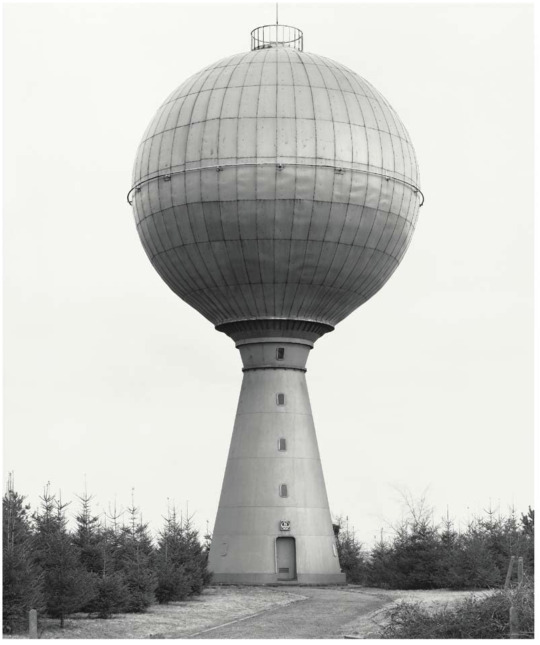
Em 1922, se pergunta Thierry de Duve, quando o arquiteto suíço Le Corbusier (Charles-Edouard Jeanneret-Gris,1887-1965) procurava o caminho para uma nova arquitetura, ou antes, em 1919 quando o arquiteto alemão Walter Gropius (1883-1969) fundou a Bauhaus, quais eram os seus referentes, que modelos citavam para uma arquitetura ainda por nascer? Ele responde: "O mais conhecido foi tirado da América industrial e celebrado tanto pelo primeiro quanto o segundo: o silo de grãos. Se você adicionar armazéns, fábricas, transatlânticos, pontes, torres de água, torres de resfriamento e gasômetros, logo temos uma tipologia de edifícios técnicos inteira, composta de "edifícios industriais", "construções" e “estruturas”. Como devemos chamar toda essa arquitetura anônima sem consciência de si mesmo?"
As imagens de Bernd e Hilla Becher estão entre essas obras, diz Duve. Não desconsidera uma modernidade que, na arquitetura como em outros campos onde a arte e a política se encontram, começou por celebrar um futuro melhor e termina ou esgota-se no desencanto do pós-modernismo, completa o pensador. Mas leva-nos de volta ao lugar onde começou a utopia da arquitetura moderna e onde, apesar de ter falhado em Sarcelles ou Brasília, acrescento, a Cidade do Amanhã ainda guarda a recordação da utopia.
Imagens © Bernd e Hilla Becher. Texto © Juan Esteves
Infos básicas:
Editora Prestel, Londres
Design: Schirmer/Mosel
Impressão EBS, Verona, Itália
Papel Gardamatt
6 notes
·
View notes
Photo

Bernd and Hilla Becher - Stoneworks, 1982 - 1992 - Sonnabend Gallery.
Bernhard "Bernd" Becher ( 1931 – 2007), and Hilla Becher, (1934 – 2015), were German conceptual artists and photographers working as a collaborative duo. They are best known for their extensive series of photographic images, or typologies, of industrial buildings and structures, often organised in grids.
As the founders of what has come to be known as the ‘Becher school’ or the ‘Düsseldorf School’ they influenced generations of documentary photographers and have been awarded the Erasmus Prize and the Hasselblad Award.
6 notes
·
View notes
Text
Bernd and Hilla Becher
“Bernhard ‘Bernd‘ Becher (20 August 1931 – 22 June 2007), and Hilla Becher, née Wobeser (2 September 1934 – 10 October 2015), were German conceptual artists and photographers working as a collaborative duo. They are best known for their extensive series of photographic images, or typologies, of industrial buildings and structures, often organised in grids. As the founders of what has come to be known as the ‘Becher school’ or the ‘Düsseldorf School’ they influenced generations of documentary photographers and artists. They have been awarded the Erasmus Prize and the Hasselblad Award. ...”
Wikipedia
Tate: Who are Hilla and Bernd Becher?
Plant for Styrofoam production (Wesseling, Germany)
Bernd and Hilla Becher, Water Towers, 1988 by Dr. Chris Balaschak
YouTube: Bernd and Hilla Becher, Hauser & Wirth Zürich, The photographers Bernd and Hilla - a documentary by Marianne Kapfer, 2012

0 notes
Text
Contemporary Architecture INSPO

Marin County Civic Centre, California (1963) by Ezra Stoller ©www.newyorker.com

New York Hall of Science, New York (1966) by Ezra Stoller ©www.newyorker.com
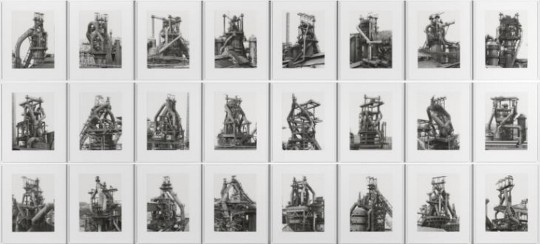
Blast Furnaces (1969–95) by Bernhard Becher and Hilla Becher ©www.tate.org.uk
0 notes
Text
Monday’s Photography Inspiration - Bernd and Hilla Becher
Monday’s Photography Inspiration – Bernd and Hilla Becher
The question ‘is this a work of art or not?’ is not very interesting for us. – Becher
Bernhard “Bernd” Bernd and Hilla Becher were German artists working as a collaborative duo. They are best known for their extensive series of photographic images, or typologies, of industrial buildings and structures.
Hilla Becher was a German artist born in 1931 in Postdam. Prior to Hilla’s time studying…

View On WordPress
#architectural photography#architecture#Bernd and Hilla Becher#Bernd Becher#Bernd Becher photography#Black & White#black and white photography#featured#Fine Art#Hilla Becher#Hilla Becher photography#industrial architecture#industrial architecture photography#Landscape photography#Photography
43 notes
·
View notes
Text
FOTOTREFF #32 – Am Samstag den 11.Januar 2020 fand der 32. Fototreff statt.
TALK
Beim FOTOTREFF #32 haben Ute Mahler, Fotografin, und Verleger und Kurator Jan Wenzel von Spector Books über ihre Erfahrungen aus der kontinuierlichen kreativen Zusammenarbeit mit PartnerInnen gesprochen.
Bernd und Hilla Becher, Onorato Krebs, Anna und Bernhard Blume – die Fotografie kennt viele Beispiele schöpferischer Teams. Doch was passiert praktisch und hinter den Kulissen kreativer Partnerschaften? Welche Motivation bringt Kreative zusammen? Wie teilt man Arbeit, Urheberrechte, Aufmerksamkeit und Misserfolg? Welche Hindernisse und Bereicherungen bedeutet Zusammenarbeit für Themenwahl, Umsetzung und das Miteinander künstlerischer Egos. Im Gespräch teilen unsere Gäste ihre Erfahrungen, Lehren und Erlebnisse mit dem kreativen Teamwork.
Ute Mahler
Ute Mahler (*1949 in Berka, Thüringen), lebt in Lehnitz bei Berlin. Ute Mahler schloss 1974 ihr Studium der Fotografie an der Hochschule für Grafik und Buchkunst in Leipzig ab. Seither arbeitet sie als freischaffende Fotografin, z.B für die Modezeitschrift Sibylle, den STERN und weitere nationale und internationale Magazine. Ab 1981 war sie Mitglied im Verband Bildender Künstler (VBK) und gründete 1990 mit sechs ostdeutschen FotografInnen die renommierte OSTKREUZ Agentur der Fotografen. Seit 2005 ist sie Dozentin an der Ostkreuzschule für Fotografie und hatte von 2000 bis 2015 eine Professur für Fotografie an der Hochschule für Angewandte Wissenschaften in Hamburg inne. Seit 2009 realisiert Ute Mahler zusammen mit ihrem Mann, dem Fotografen Werner Mahler, freie künstlerische Projekte im dokumentarischen Stil. Ihre Arbeiten wurden weltweit in zahlreichen Ausstellungen präsentiert. 2019 wurden sie gemeinsam für ihr Lebenswerk mit der David-Octavius-Hill-Medalle der Deutschen Fotografischen Akademie ausgezeichnet.
Jan Wenzel
Jan Wenzel lebt als Verleger, Autor und Künstler in Leipzig. Zusammen mit Markus Dreßen und Anne König hat er 2001 den Verlag Spector Books gegründet, der 2018 den Sächsischen Verlagspreis und 2019 den Deutschen Verlagspreis erhielt. Als Autor und Herausgeber hat er an einer Vielzahl von Buchprojekten mitgearbeitet, u.a. mit den Künstlern Olaf Nicolai, Alexander Kluge und Erik van der Weijde. 2016 und 2018 kuratierte er gemeinsam mit Anne König das Fotofestival f/stop in Leipzig.
BOOK SLOT
Im zweiten Teil des Abends wurde das Fotobuch „Be Hers Be Mine“ (2019, Kehrer Verlag) von Djamilia Grossman und Tom Licht vorgestellt.

Ein Schweizer Paar versucht acht Jahre lang vergeblich schwanger zu werden. Nach etlichen Behandlungsmethoden haben sie Adoptionspläne – doch jeder Versuch scheitert. Obwohl es in der Schweiz verboten ist, bitten sie schließlich eine Frau in den USA, den im Labor gezeugten Embryo in ihren Uterus einzusetzen und ihr Kind auszutragen. Die Fotografen Tom Licht und Djamila Grossman beschreiben den Weg des Paares und die Beweggründe, die zur Entscheidung für eine Leihmutterschaft führen. Fasziniert von den Fragen, die ihre Geschichte aufwirft, begleiten sie die Eltern zur Geburt des Kindes in die USA. Leihmutterschaft reflektiert eine globale Realität, in der die Grenzen verschwimmen zwischen technischem Fortschritt, Medizin, Ethik und dem Gesetz. Mit dem Eingriff stellen sich Fragen zur Identität des Menschseins, und die Kreation von Leben wird zur globalgesellschaftlichen Aufgabe.
Djamila Grossman
Djamila Grossman ist deutsch-amerikanische Fotografin und lebt in Zürich. Sie studierte Journalismus und Anthropologie an der University of Arizona und absolvierte die Meisterklasse von Ute Mahler und Robert Lyons an der Ostkreuzschule für Fotografie in Berlin. Djamila Grossman arbeitet international für redaktionelle und kommerzielle Kunden und realisiert zudem persönliche Langzeitprojekte. Ihre Arbeit zeichnet sich aus durch eine intuitive Herangehensweise und visuelle Sprache.
Tom Licht
Tom Licht lebt und arbeitet als freier Fotograf in Zürich. Fokus sind Architekturfotografie, Portraits und freie Projekte. In seinen Arbeiten beschäftigt er sich hauptsächlich mit der Identität und ihrer Prozesshaftigkeit. Er studierte Architektur und absolvierte die Meisterklasse von Ute Mahler und Robert Lyons an der Ostkreuzschule für Fotografie in Berlin. Sein Buch Vater Sohn und der Krieg war 2016 für den Deutschen Fotobuchpreis nominiert.
SHOW & TELL
Im letzten Teil des Abends hat Fabian Zapatka Fotografien seiner aktuellen Arbeit präsentiert.
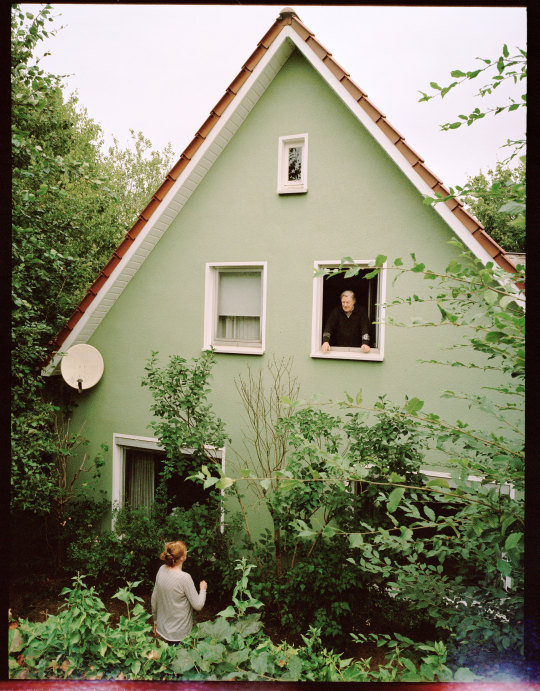
Nach über fünfzig Jahren auf der Bühne, beendete Fabian Zapatkas Vater, der Schauspieler Manfred Zapatka, im Sommer 2019 seine Bühnenkarriere. Er hat ihn mit der Kamera beim Abschied nehmen und dem Rückzug in sein alte Heimat begleitet.
Eine Auswahl der Bilder erschien als Titelgeschichte im Magazin der Süddeutschen Zeitung 2020 unter dem Titel “Nach Hause”.
► Podcast des Gesprächs auf Soundcloud:

► Podcast des Gesprächs auf Spotify
► Podcast des Gesprächs auf Podigee
Supported by:
RECOM ART
PicDrop - Image Transfer for Pros
RENT ONE - Fototechnikverleih
DRS Delight Rental Services
Buch- und Offsetdruckerei H.Heenemann GmbH & Co. KG
4 notes
·
View notes
Text
Die Piefkes planen Nägel mit Köpfen
LePenseur:»von LePenseur Was steht im deutschen Gesetzesentwurf zur Einführung der Impfpflicht? Das:Wenn die Festsetzung eines Zwangsgeldes nicht zur Vornahme der Handlung durch den Pflichtigen führt, könnte diese nach dem Verwaltungs-vollstreckungsrecht grundsätzlich auch durch unmittelbaren Zwang (§ 12 VwVG) vollstreckt werden. Unmittelbarer Zwang ist die Einwirkung auf Personen oder Sachen durch körper-liche Gewalt, Hilfsmittel oder Waffen. Kann ein Zwangsgeld beim Pflichtigen nicht eingebracht werden, so ist unter weiteren Voraussetzungen auch eine Ersatz-zwangshaft möglich (§ 16 VwVG).Da kann man nach schlechtem historischem Vorbild nur sagen: »Wollt ihr die totale Impfpflicht? Wollt ihr sie – wenn nötig – totaler und radikaler, als wir sie uns heute überhaupt erst vorstellen können?«
JAAAAA!!!Oder: »Karl befiehl! Wir folgen« ... oder so halt ...
Wir Ösis sollten uns aber angesichts der totalitären Ansagen des Tarnanzug-Geckos vor ein paar Tagen nicht in Sicherheit wiegen, daß das bei uns nicht ebenso kommen kann. Denn im Unterschied zu Deutschland haben wir die Zwangsimpfung bereits im Gesetzesrang verankert — jederzeit durch unsere Staatsverbrecher exekutierbar. Da reicht eine kleine Verordnung des Gesundheitsministers, und die Zwangsimpfung ist Realität.
-----
P.S.: habe ich schon erwähnt, daß ich den Politruks, die diesem Gesetz im Nationalrat zugestimmt haben, wie auch dem Hofbürger einen baldigen — wohlgemerkt: natürlichen! — Tod wünsche? Wer aus Postengier, Bestechlichkeit oder bloßem Desinteresse an den Grundrechten der Mitbürger so einen Skandal einfach abnickt, kann von mir aus jederzeit ableben, ohne daß mich darob größere Trauer befiele. Konkret handelt es sich um folgende Abgeordnete (in alphabetischer Reihung):
Baumgartner, Bayr, Becher, Berlakovich (Nikolaus), Bernhard, Blimlinger, Brandstätter (Helmut), Brandstötter (Henrike), Brandweiner, Bures, Bürstmayr;
Deckenbacher, Diesner-Wais, Disoski, Doppelbauer, Drobits;
Ecker (Cornelia), Egger (Kurt), Einwallner, El-Nagashi, Engelberg, Erasim, Eßl;
Feichtinger, Fürlinger;
Gahr, Gerstl, Gödl, Götze, Graf (Tanja), Grebien, Greiner (Karin), Großbauer;
Hamann (Sibylle), Hammer (Lukas), Hammer (Michael), Hanger (Andreas), Haubner, Hechenberger, Heinisch-Hosek, Herr, Himmelbauer, Hintner, Hofinger (Manfred), Höfinger (Johann), Holzleitner, Holzner, Hörl, Hoyos-Trauttmansdorff;
Jachs, Jeitler-Cincelli;
Kaufmann, Keck, Kirchbaumer, Köchl, Köllner, Kollross, Kopf, Koza, Krainer (Kai Jan), Kucharowits, Kucher (Philip), Kühberger, Künsberg (Sarre), Kuntzl;
Leichtfried, Lindner, Lindinger, Lopatka;
Marchetti, Matznetter, Maurer, Meinl-Reisinger, Melchior, Minnich;
Neßler, Neumann-Hartberger, Niss (Maria Theresia), Nussbaum;
Obernosterer, Oberrauner (Petra), Ofenauer (Friedrich), Ottenschläger;
Pfurtscheller, Pöttinger, Prammer, Prinz;
Rausch (Bettina), Reimon, Rendi-Wagner, Ribo, Rössler;
Salzmann, Saxinger, Schallmeiner, Scharzenberger, Schatz, Scherak, Scheucher-Pichler, Schmuckenschlager, Schnabel, Schroll, Schwarz (Gabriela), Schwarz (Jakob), Seemayer, Seidl, Shetty, Sieber (Norbert), Smodics-Neumann, Smolle, Sobotka, Stammler, Stark, Steinacker, Stocker, Stöger (Alois), Stögmüller, Strache, Strasser;
Tanda, Taschner, Tomaselli, Totter, Troch;
Voglauer;
Weber, Weidinger, Weratschnig, Werner, Wimmer (Petra), Wimmer (Rainer), Wöginger;
Yildirim, Yılmaz;
Zarits (Christoph), Zopf, Zorba. http://dlvr.it/SMQghQ «
0 notes
Text

Bernhard “Bernd” Becher August 20, 1931 – June 22, 2007), and Hilla Becher, (September 2 1934 – October 13, 2015), were German conceptual artists and photographers working as a collaborative duo. They are best known for their extensive series of photographic images, or typologies, of industrial buildings and structures, often organised in grids.
1 note
·
View note
Text
The New German Objectivity: The Dusseldorf School.
The New German Objectivity: The Dusseldorf School.
I’ve been watching a documentary program on Acorn TV called Photo by Luciano Rigolini it’s a 12-part series that explores the development of photography from its beginnings to more recent times. Here’s a link to the program Trailer for PHOTO
Episode #3 called The New German Objectivity: The Dusseldorf School of the 1960s sought to preserve the memory of a disappearing world as the industrial…
View On WordPress
#abandoned buildings#art#artist#artwork#documentary#Grimalkin Studio#history#photo#Photographers Bernhard and Hilla Becher#photography#The Dusseldorf School#Travel#Visual art
0 notes
Photo

Bernd and Hilla Becher, Winding Towers, (nine gelatin silver prints), 1966-1997 [MoMA, New York, NY. © Estate of Bernd Becher and Hilla Becher]
#art#photography#geometry#pattern#structure#bernhard becher#hilla becher#moma#the museum of modern art#1960s#1990s
202 notes
·
View notes
Link
REFLECTING CONSTRUCTING: TYPOLOGY
Bernhard Bernd and Hilla Becher were German conceptual artists and photographers working as a collaborative duo. They are best known for their extensive series of photographic images, or typologies, of industrial buildings and structures, often organised in grids. As the founders of what has come to be known as the ‘Becher school’ or the ‘Düsseldorf School’ they influenced generations of documentary photographers and artists.
0 notes
Photo

Bahrain I 2005 is a very large portrait format colour photograph by the German artist Andreas Gursky of the Bahrain International Circuit, a motorsport race track completed in 2004 that hosts the country’s annual Formula One Grand Prix. Taken from a helicopter and subsequently manipulated using digital software, the photograph shows the track curving in a snake-like fashion through the desert landscape, the black asphalt forming a strong contrast with the beige sand surrounding it. No cars or people are visible in the image, although a long horizontal grandstand with a white roof can be seen just above the centre of the composition. A cluster of distant buildings are also perceptible near the horizon underneath a hazy grey-blue sky.Gursky, whose father and grandfather were also photographers, was trained between 1981 and 1987 at the Arts Academy in Düsseldorf, the city where he continues to live and work.
During his studies he was taught by the German photographers Bernd (Bernhard) Becher (1931–2007) and Hilla Becher (born 1934). The objective and systematic approach to photographing industrial structures that the Bechers emphasised in their own work (see, for example, Coal Bunkers 1974, Tate T01923) proved highly influential on Gursky and a wider group of photographers at the Arts Academy, including Candida Höfer and Thomas Ruff, who studied alongside Gursky, and Thomas Struth and Axel Hütte, who completed their studies there in 1980. These photographers have become known collectively as the Düsseldorf School of Photography (Tate Gallery).
11 notes
·
View notes
Text
TYPOLOGIES
Jeff Brouws
He has born in 1955, San Francisco. Jeff is a self-taught artist. He is pushing himself into photography since 13 years old. He has complied a visual survey of America’s evolving rural, urban and suburban cultural landscapes. Brouws to show the photograph as subtle narrative and compiling typologies to index the nation’s character he used single photographs, he revels in the ‘’redymades’’ found in many of these environments.

Hilla Becher
She has born in September 2, 1934 and died October 10, 2015. She was German. Hilla was working in duo with Bernhard Becher. They were conceptual artists and photographers. The collaborative duo was known for the series of photographic images, typologies of industrial buildings and structures, often organised in grids. They are founders of ‘’Becher school’. They influenced generations of documentary photographers and artist. Bernhard and Hilla have been awarded the Erasmus Prize and the Hasselblad Award.

Karl Blossfeldt
Karl has born in 13 June, 1865 in Schielo, Germany and died in 9 December 1932, Berlin. He is know from his stark close-up portraits of plants, twigs, seeds, leaves and other flora. At the beginning in 1898 Blossfedlt taught design at the school of the Museum of Decorative Arts and then in 1930 he became professor emeritus. Blossfeldt didn’t had any formal training as a photographer and used homemade cameras that he outfitted with lenses capable of magnifying his subjects up to 30 times their natural size. He used photograph the natural world for scientific and pedagogical purposes and inadvertently became a modern artist. In 1926 his work was exhibited to the public for the first time at Berlin’s avant-grade Galerie Nierendorf. The works exhibited there were published in the book Unformen der Kunst.

And this is my typology of windows:

Our task was to make a typology, which I make from windows.
0 notes
Link
Photographs from the Ginny Williams Collection
https://ift.tt/2CwlS2V
Sotheby’s is honored to present Photographs from the Ginny Williams Collection on 14 July, an auction of approximately 100 photographs celebrating Williams’s passion for the medium as well as her dedication to the work of female creators.
A dynamic force in the photographs market for more than three decades, by the time of her passing, Ginny had collected more than 1,000 photographs. In addition to photographs by Dorothea Lange, Berenice Abbott, Laura Gilpin, Diane Arbus, Margaret Bourke-White, and Ruth Bernhard, whose work Williams exhibited and passionately championed at her first gallery exhibition in Denver, the auction features Tina Modotti’s Interior of Church Tower at Tepotzotlán, Mexico, Edward Weston’s Dunes, Oceano, and Herbert Bayer’s In Search of Times Past. Contemporary highlights include unique works by Lucas Samaras, Gerhard Richter, and Adam Fuss, as well as typologies by Bernd and Hilla Becher.
The photographs in the Ginny Williams Collection display a breadth of vision and connoisseurship that is nothing short of remarkable. Sotheby’s sales of The Ginny Williams Collection will continue throughout 2020.
For assistance with bidding and registration, please contact:
+1 212 606 7000
For all enquiries please contact:
Emily Bierman
Vice President
Head of Department, Photographs
+1 212 894 1149
Aimee Pflieger
Assistant Vice President
Specialist, Head of Sale
Photographs
+1 212 894 1149
Hermione Sharp
Associate Specialist
Photographs
+1 212 894 1149
Kelly Sidley
Associate Specialist & Senior Researcher
Photographs
+ 212 894 1149
Lucie Kessler
Senior Administrator
Photographs
+1 212 894 1149
Begins: July 14, 2020 at 05:00PM
Latitude: 40.766287
Longitude: -73.953544
Learn more on Sotehbys.com
0 notes
